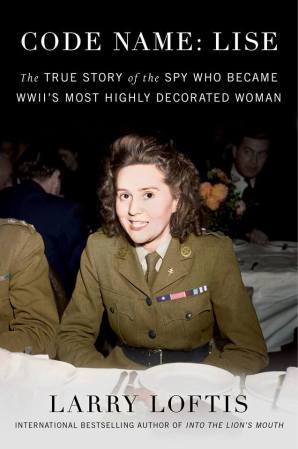
When it comes to writing nonfiction that reads like a thriller, you won’t find a better author than Larry Loftis.
A few years ago, Loftis penned the nonfiction account of Dusko Popov, the real-life inspiration for James Bond, titled Into the Lion’s Mouth. It was then that I became hooked on his writing style, which is structured and delivered as such that you genuinely forget that what you’re reading is all true. I sure did. Quite honestly, it’s a feat that not many other people could pull off, which is why I was thrilled to get my hands on Loftis’ second nonfiction thriller, Code Name: Lise.
With every chapter ending in a page-turning cliffhanger, Loftis’ latest reads as fast as a Brad Thor book, with the keen attention to historical details often seen from Brad Meltzer. The fact that Odette Sansom’s story is real is just icing on the cake, and Loftis depicts her harrowing journey with the vivid touch of a master. Bottom line: if you read one nonfiction book this year, make it this one.
Read my brief Q&A with Loftis below, then click here to order your copy of Code Name: Lise, available in bookstores on January 15th.
TRBS: Following Into the Lion’s Mouth, you’re back with another nail-biting nonfiction book, this time about Odette Sansom. How did you first hear about her, and what made you want to write about her?
Loftis: “When I finished Into the Lion’s Mouth I was really bummed because I knew I’d never find a character so intriguing as Dusko Popov. He was, in my opinion, the greatest spy in history (he had more sub-agents, was involved in more operations, and accomplished more than any other agent). Then there was the whole James Bond aspect. He was a dream protagonist.
“For months I scoured the UK National Archives and my WWII resources and came up empty. I moved on to a Polish double agent (Roman Czerniawski) who ran a large Allied circuit (INTERALLIÉ) in Paris, and investigated his operation and network. One of the books I read was by Hugo Bleicher, the German secret policeman who infiltrated INTERALLIÉ and destroyed it in 1941. Hugo described moving on to chase another Allied circuit the following year, one involving a woman named ‘Lise.’ The more I read, the more excited I became. It was a circuit called SPINDLE, and the cat and mouse chase between Bleicher and SPINDLE’s leaders—Peter Churchill and Odette Sansom—involved more chills and thrills than even the Popov story. Then there was a surprise benefit: a love story. It was almost too good to be true. I had to write the book.”
TRBS: How much research did you have to do before actually sitting down to write, and what’s your writing schedule like? Do you have a target word count you try to hit each day, etc.?
Loftis: “With Into the Lion’s Mouth, I spent the better part of two years doing research. But with CODE NAME: LISE, I was able to cut that in half because I stayed within the WWII espionage genre. Many of the 100 books I purchased for ILM research, for example, I could use again, and I often knew what sections to turn to. The research for ILM gave me a great understanding of how British Intelligence operated during WWII and how the UK Archives work today. I also knew Bleicher’s story intimately, as I had come across his name many times in the archives and memoirs of other agents. All of that is simply foundation, of course, but it eliminated a lot of work. It allowed me to focus only on the principal characters of SPINDLE and not be bogged down with background material.
“As for my schedule, I like to do the mundane work (i.e., emails, social media, etc.) in the morning, write in the afternoon, and read/research in the evening. I like what Lee Child says: ‘Nothing good happens before noon.’
“On word count, it is much harder with nonfiction because every sentence has to be backed up by a source citation. When I write a paragraph, I then have to stop and add the endnotes that give the citations for every point or bit of dialogue. It’s quite time consuming, so it’s difficult to write more than 500 words a day (what Hemingway thought was a good day, and he was writing fiction). So my aim is 500 words. If I’ve had a Monster and I’m on a roll, I can sometimes churn out 750 words, but that’s once a week at best. There are many, many days where I have to spend most of the day just in the endnotes, many of which are ‘speaking’ (i.e., notes that provide details which couldn’t be put in the main text because it would kill the pace).”
TRBS: You have a really unique writing style in that while your books are nonfiction, they read like thrillers. How did that come about, and what are some of the challenges of writing nonfiction?
Loftis: “I appreciate you noticing! It comes from my background as a lawyer (nonfiction), and my love for great thrillers. Before writing Into the Lion’s Mouth, I had published quite a bit of scholarly legal articles in university law reviews and professional bar journals. I then moved on to business books (when invited by a publisher to write one), eventually writing three, but found the topics dry and boring.
“Not long after that, a friend turned me on to your favorite, Vince Flynn, and I found a home. I read most of his books and loved them. I then found Elleston Trevor (writing as Adam Hall from 1963 to 1996), and I was enraptured. His main character, Quiller, is a spy for MI6 (although never identified as such), and every page Trevor wrote is pure poetry.
“So my background and my passion for thrillers (and creative writing) converged. I had never seen (or heard of) a nonfiction thriller, but that’s what I wanted to do. I wanted the pace that you have in a Flynn or Trevor novel, but with real people from history. I also wanted to scratch the itch for quality writing: prose that carefully integrates meter, assonance, and consonance. [The reason the Psalms are so beautiful, and so memorable, is because of those three elements.]
“The difficulty in writing a nonfiction thriller, of course, is that I can’t make anything up! I can’t ‘bring a gun in for chapter 3,’ or have the main character find a dead body, or create a reversal or cliffhanger, as novelists do. My action, my intrigue, my cliffhangers, all have to be actual history. As such, it is almost impossible to find a character to write about! It took me a year or more to find Odette Sansom, and my greatest fear is that I won’t find another character to match her and Popov.”
TRBS: Who are some of your favorite authors, and what is the last great book that you read?
Loftis: “Let’s start with the topic at hand: thrillers. As I mentioned above, I love Vince Flynn. However, as good as he is, I’d put Alistair Maclean (Where Eagles Dare, The Guns of Navarone, When Eight Bells Toll) ahead of him, and by a good margin. But Elleston Trevor (writing as Adam Hall for the Quiller series) is in a league of his own, far ahead of Maclean. As I wrote in a recent review of Flaubert’s Madame Bovary, Trevor’s writing is better than the famous Frenchman’s. And no one can touch Trevor for plot, intrigue, spycraft, cliffhangers, reveals, etc. His book endings are sometimes weak (whose aren’t?), but the writing and storyline of every novel are so good, you don’t really care.
“Other novelists I enjoy simply for the quality of their writing are Dostoyevsky, Flaubert, Wilde, Lewis, Chesterton, Orwell, Rand, and today’s Ken Follett. I”m also dying to read A Gentleman in Moscow because I’ve heard so many good things about Amor Towles’ writing.
“The last great book I’ve read is Elleston Trevor/Adam Hall’s The Kobra Manifesto. I believe it’s the greatest thriller ever written, and one of the greatest novels. From cover to cover, it’s a masterpiece.”
TRBS: Lastly, what’s next for you, and is there a chance you might write a novel in the future?
Loftis: “Ha! My agent is asking the same question! I have been researching three WWII spies recently, but all seem to have insufficient material for a book. I have seriously considered writing a novel, but I think that may be a few years off. What’s the next best thing? A screenplay! I’ve written a screenplay for Into the Lion’s Mouth (another story, best told over drinks), and may write a script for CODE NAME: LISE. It scratches the creativity itch the way a novel does, and is quite fun since I don’t have to do additional research. My agent has received quite a bit of interest in CNL from Hollywood, and we’ve rejected two offers. But I think something will eventually pan out for both books in the near future.”
 Best Nonfiction Books to Read in 2019—Woman’s Day
Best Nonfiction Books to Read in 2019—Woman’s Day
From internationally bestselling author of the “gripping” (Michael Connelly, #1 New York Times bestselling author) Into the Lion’s Mouth comes the extraordinary true story of Odette Sansom, the British spy who operated in occupied France and fell in love with her commanding officer during World War II—perfect for fans of Unbroken, The Nightingale, and Code Girls.
The year is 1942, and World War II is in full swing. Odette Sansom decides to follow in her war hero father’s footsteps by becoming an SOE agent to aid Britain and her beloved homeland, France. Five failed attempts and one plane crash later, she finally lands in occupied France to begin her mission. It is here that she meets her commanding officer Captain Peter Churchill.
As they successfully complete mission after mission, Peter and Odette fall in love. All the while, they are being hunted by the cunning German secret police sergeant, Hugo Bleicher, who finally succeeds in capturing them. They are sent to Paris’s Fresnes prison, and from there to concentration camps in Germany where they are starved, beaten, and tortured. But in the face of despair, they never give up hope, their love for each other, or the whereabouts of their colleagues.
In Code Name: Lise, Larry Loftis paints a portrait of true courage, patriotism, and love—of two incredibly heroic people who endured unimaginable horrors and degradations. He seamlessly weaves together the touching romance between Odette and Peter and the thrilling cat and mouse game between them and Sergeant Bleicher. With this amazing testament to the human spirit, Loftis proves once again that he is adept at writing “nonfiction that reads like a page-turning novel” (Parade).
Praised as “one of today’s finest book reviewers” by New York Times bestselling author Gayle Lynds, Ryan Steck (“The Godfather of the thriller genre” — Ben Coes) has “quickly established himself as the authority on mysteries and thrillers” (Author A.J. Tata). Steck also works full-time as a freelance editor and pens a monthly thriller column for CrimeReads. For more information, be sure to follow him on Twitter and Facebook. He currently lives in Southwest Michigan with his wife and their six children.
